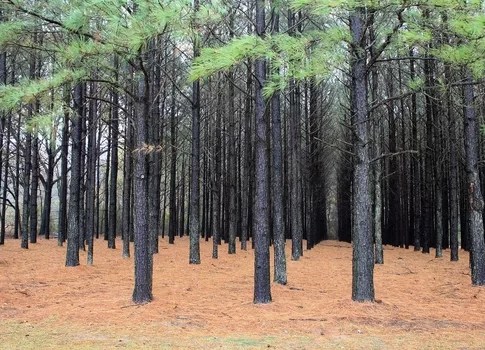Plantation forestry in Australia has been successfully implemented in various regions, showcasing the potential for sustainable timber production, environmental conservation, and economic benefits.
Here are some notable examples of plantation forestry in Australia. Story continues after this advertisement:
1. Green Triangle Region (South Australia and Victoria)
The Green Triangle region, spanning the border between South Australia and Victoria, is one of Australia’s largest and most productive plantation forestry areas. Key characteristics include:
- Species: Predominantly Pinus radiata (Monterey Pine) and Eucalyptus globulus (Tasmanian Blue Gum).
- Economic Impact: The region supports a significant forestry industry, contributing billions to the local economy through timber, pulpwood, and paper production.
- Environmental Benefits: Plantations in this region help reduce pressure on native forests and provide ecosystem services such as carbon sequestration and soil stabilization.
2. South West Slopes (New South Wales)
The South West Slopes region of New South Wales is another prominent area for plantation forestry, characterized by:
- Species: Mainly Pinus radiata, with some Eucalyptus species.
- Economic Impact: This region has a well-developed forestry sector, with numerous sawmills and processing facilities providing employment and economic growth.
- Environmental Benefits: Plantations in this area contribute to land rehabilitation and erosion control, enhancing the overall landscape health.
3. Western Australia Plantations
Western Australia has several plantation forestry projects that contribute significantly to the state’s timber industry:
- Species: Eucalyptus globulus (Tasmanian Blue Gum) and Pinus pinaster (Maritime Pine).
- Economic Impact: The industry supports local economies, particularly in rural areas, through the production of high-quality timber and wood chips for export.
- Environmental Benefits: Plantations aid in salinity management and improve soil conditions, making previously degraded land productive again.
4. Northern Territory Plantations
The Northern Territory has emerging plantation forestry projects, particularly focusing on tropical hardwood species:
- Species: Acacia mangium and various Eucalyptus species.
- Economic Impact: These plantations are part of efforts to diversify the economy, providing opportunities for local employment and export revenues.
- Environmental Benefits: The projects help restore degraded lands, enhance biodiversity, and contribute to carbon sequestration efforts.
5. Maryborough Region (Queensland)
The Maryborough region in Queensland has a long history of plantation forestry, with well-established plantations:
- Species: Hoop Pine (Araucaria cunninghamii) and various Eucalyptus species.
- Economic Impact: The region has a thriving timber industry, supporting local economies through sawmills, wood processing, and export activities.
- Environmental Benefits: Plantations in this area help protect water catchments, reduce soil erosion, and provide habitats for wildlife.
6. Tasmania’s Plantations
Tasmania has extensive plantation forestry operations, contributing significantly to the state’s economy:
- Species: Eucalyptus nitens (Shining Gum) and Pinus radiata.
- Economic Impact: The plantation sector supports a robust forestry industry, including timber production, paper manufacturing, and bioenergy.
- Environmental Benefits: Plantations help in conserving native forests, enhancing biodiversity corridors, and sequestering carbon.
Case Studies and Success Stories
Albany Plantation Export Company (APEC)
- Location: Albany, Western Australia
- Focus: Export of wood chips from Eucalyptus globulus plantations.
- Impact: APEC has established itself as a significant player in the export market, contributing to the local economy and promoting sustainable forestry practices.
Hancock Victorian Plantations (HVP)
- Location: Victoria
- Focus: Management of extensive Pinus radiata and Eucalyptus plantations.
- Impact: HVP is a major contributor to Victoria’s forestry sector, providing raw materials for the construction and paper industries while implementing sustainable forestry management practices.
Plantation forestry in Australia demonstrates a successful model of balancing economic, environmental, and social benefits. These examples highlight how different regions have leveraged plantation forestry to support local economies, restore degraded lands, and contribute to sustainable development.
By continuing to address challenges and implement best practices, Australia can further enhance the impact and sustainability of its plantation forestry sector.
Related stories
Forestry Corp Admits Guilt Destroyed Vital Trees
Endangered Greater Glider Killed in Yarra Ranges National Park
The Battle for Wild Cattle Creek State Forest
Illegal Logging in Styx River State Forest Must Stop
Biodiversity Appreciation: Insights from the Community
MPs $64,000 question – Save Koalas or logging trucks
NSW Forestry Corp fines exceed $1,000,000 since 2019 fires
Forestry Corp NSW forms a special police branch
Citizen Scientists Take Action in Bulga State Forest
Logging Threatens Koala Habitat Despite Community’s Pleas
EPA stops logging at Flat Rock State Forest
EPA’s Stop Work Order extended in Tallaganda State Forest
Greater Glider heading for extinction
NSW Forestry Corp have a fight on their hands to Save Bulga Forest
Midcoast Council Votes to Save Bulga Forest on Biripi Country
The Great Koala National Park without any Koalas
Is AUKUS damaging Australia’s relationship with China?
Era of Change: 1960s-70s Revolution & Welcome to Country
Please comment below or visit our advertisers, if this is interesting to you. ChatGPT assisted. Thanks for visiting our growing magazine.




